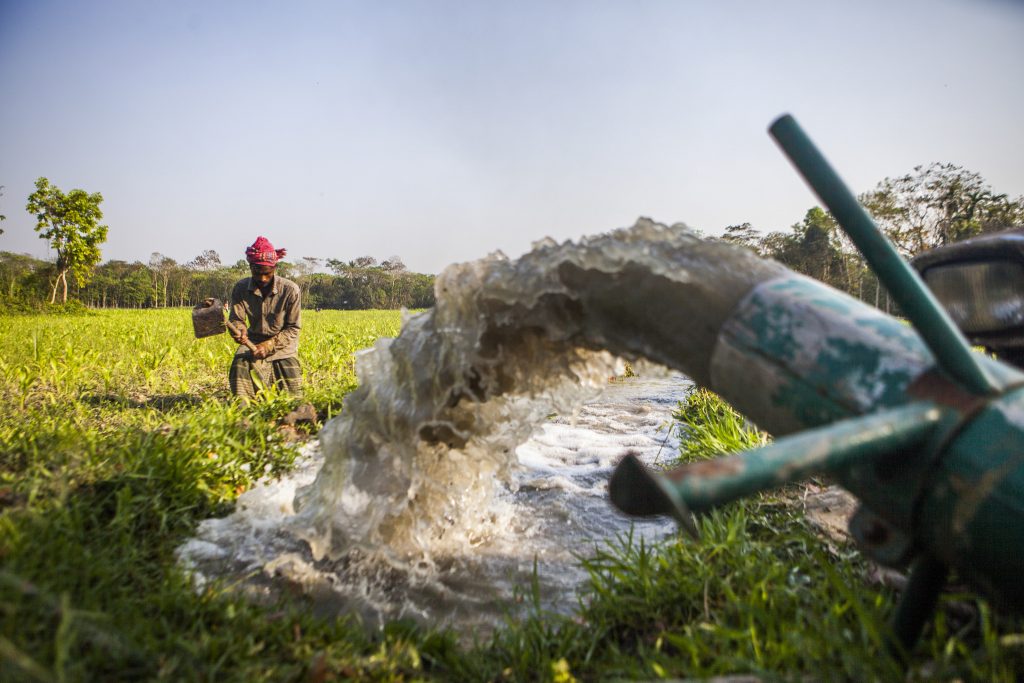New technologies are at the core of sustainable agricultural growth and rural poverty alleviation, says Khondoker Mottaleb, an Agricultural Economist working within CIMMYT’s Socioeconomic Program. However, he explains, despite the visible benefits of using new agricultural machinery or farm management practices, overall uptake remains low as a range of factors continue to limit farmers’ ability to invest.
In a bid to enhance irrigation efficiency, Bangladesh has tried to introduce and popularize the use of axial-flow pumps (AFPs) for surface water irrigation. These pumps can lift up to 55 percent more water than a conventional centrifugal pump, but despite the obvious benefits, there has been limited uptake in targeted areas of the country. From 2012-13, a CIMMYT initiative made AFPs available for purchase for farmers in the southern regions of Bangladesh, but as of September 2017 only 888 had been purchased by lead farmers and irrigation service providers.
A recent study by CIMMYT in Bangladesh used primary data collected from 70 irrigation service providers – each of whom was given a free AFP for one season under a demonstration program – to examine user perception of AFPs and the major constraints to their adoption. It found that even though the use of AFPs can significantly reduce irrigation and overall crop production costs, more demonstrations and awareness-raising programs are needed if uptake is to be increased in target areas.
The study also highlighted the need for continuous modification of new technologies based on farmers’ requirements, with Mottaleb emphasizing that these must be adapted to local demand specifications, and that prices must be competitive with those of alternative technologies in order to ensure rapid uptake.
This study was supported by USAID through the Cereal Systems Initiative for South Asia – Mechanization and Irrigation (CSISA-MI) project. It was also supported by USAID and the Bill and Melinda Gates Foundation through the Cereal Systems Initiative for South Asia (CSISA) Phase II project.
Read the full article in Science Direct: “Perception and adoption of a new agricultural technology: Evidence from a developing country.”

Check out other recent publications by CIMMYT researchers below:
- Bayesian functional regression as an alternative statistical analysis of high-throughput phenotyping data of modern agriculture. 2018. Montesinos-López, A., Montesinos-Lopez, O.A., De los Campos, G., Crossa, J., Burgueño, J., Luna-Vazquez, F.J. In: Plant Methods v. 14, art. 46.
- Exploring the physiological information of sun-induced chlorophyll fluorescence through radiative transfer model inversion. 2018. Celesti, M., van der Tol, C., Cogliati, S., Panigada, C., Peiqi Yang, Pinto Espinosa, F., Rascher | Miglietta, F., Colombo, R., Rossini, M. In: Remote Sensing of Environment v. 215, p. 97-108.
- Genome-wide association mapping for resistance to leaf rust, stripe rust and tan spot in wheat reveals potential candidate genes. 2018. Juliana, P., Singh, R.P., Singh, P.K., Poland, J.A., Bergstrom, G.C., Huerta-Espino, J., Bhavani, S., Crossa, J., Sorrells, M.E. In: Theoretical and Applied Genetics v. 131, no. 7, p. 1405-1422.
- High-throughput method for ear phenotyping and kernel weight estimation in maize using ear digital imaging. 2018. Makanza, R., Zaman-Allah, M., Cairns, J.E., Eyre, J., Burgueño, J., Pacheco Gil, R. A., Diepenbrock, C., Magorokosho, C., Amsal Tesfaye Tarekegne, Olsen, M., Prasanna, B.M. In: Plant Methods v. 14, art. 49.
- Long-term impact of conservation agriculture and diversified maize rotations on carbon pools and stocks, mineral nitrogen fractions and nitrous oxide fluxes in inceptisol of India. 2018. Parihar, C.M., Parihar M.D., Sapkota, T.B., Nanwal, R.K., Singh, A.K., Jat, S.L., Nayak, H.S., Mahala, D.M., Singh, L.K., Kakraliya, S.K., Stirling, C., Jat, M.L. In: Science of the Total Environment v. 640-641, p. 1382-1392.
- Major biotic maize production stresses in Ethiopia and their management through host resistance. 2018. Keno, T., Azmach, G., Dagne Wegary Gissa, Regasa, M.W., Tadesse, B., Wolde, L., Deressa, T., Abebe, B., Chibsa, T., Mahabaleswara, S. In: African Journal of Agricultural Research v. 13, no. 21, p. 1042-1052.
- Detection of aflatoxigenic and atoxigenic mexican aspergillus strains by the dichlorvos–ammonia (DV–AM) method. 2018. Masayo Kushiro, Hidemi Hatabayashi, Kimiko Yabe, Loladze, A. In: Toxins v. 10, no. 7, art. 263.
- Excessive pruning and limited regeneration: Are Faidherbia albida parklands heading for extinction in the Central Rift Valley of Ethiopia? 2018. Tesfaye Shiferaw Sida, Baudron, F., Dejene Adugna Deme, Motuma Tolera, Giller, K.E. In: Land Degradation and Development v. 29, no. 6, p. 1623-1633.
- Multi-temporal and spectral analysis of high-resolution hyperspectral airborne imagery for precision agriculture: Assessment of wheat grain yield and grain protein content. 2018. Rodrigues, F., Blasch, G., Defourny, P., Ortiz-Monasterio, I., Schulthess, U., Zarco-Tejada, P.J., Taylor, J.A., Gerard, B. In: Remote Sensing v. 10, no. 6, art 930.
- Screening and validation of fertility restoration genes (Rf) in wild abortive CMS system of rice (Oryza sativa L.) using microsatellite markers. 2018. Bhati, P.K., Singh, S.K., Kumar, U. In: Indian Journal of Genetics and Plant Breeding v. 78, no. 2, p. 270-274.
- Time-series multispectral indices from unmanned aerial vehicle imagery reveal senescence rate in bread wheat. 2018. Hassan, M.A., Mengjiao Yang, Rasheed, A., Xiuliang Jin, Xianchun Xia, Yonggui Xiao, He Zhonghu. In: Remote Sensing v. 10, no. 6, art. 809.
- Natural variation in elicitation of defense-signaling associates to field resistance against the spot blotch disease in bread wheat (Triticum aestivum L.). 2018. Sharma, S., Ranabir Sahu, Sudhir Navathe, Vinod Kumar Mishra, Chand, R., Singh, P.K., Joshi, A.K., Pandey, S.P. In: Frontiers in Plant Science v. 9, art. 636.
- Population structure of leaf pathogens of common spring wheat in the West Asian regions of Russia and North Kazakhstan in 2017. 2018. Gultyaeva, E.I., Kovalenko, N.M., Shamanin, V.P., Tyunin, V.A., Shreyder, E.R., Shaydayuk, E.L., Morgunov, A.I. In: Vavilovskii Zhurnal Genetiki i Selektsii v. 22, no. 3, p. 363-369.
- The ADRA2A rs553668 variant is associated with type 2 diabetes and five variants were associated at nominal significance levels in a population-based case–control study from Mexico City. 2018. Totomoch-Serra, A., Muñoz, M. de L., Burgueño, J., Revilla-Monsalve, M.C., Perez-Muñoz, A., Diaz-Badillo, A. In: Gene v. 669, p. 28-34.